Intro
Methylprednisolone is a potent steroid medication, also known as Medrol, used to treat inflammation, autoimmune diseases, and allergic reactions, with benefits including reduced swelling and immune system suppression.
Methylprednisolone is a synthetic steroid that belongs to the class of corticosteroids. It is commonly used to treat a wide range of inflammatory conditions, including arthritis, asthma, and allergies. The medication works by reducing inflammation and suppressing the immune system, which can help to alleviate symptoms and prevent further damage to the body. Methylprednisolone is available in various forms, including tablets, injections, and topical creams, and is often prescribed by doctors to patients who require short-term or long-term treatment for their condition. With its potent anti-inflammatory properties, methylprednisolone has become a popular treatment option for many patients, but it is essential to use the medication responsibly and under the guidance of a healthcare professional.
The importance of understanding methylprednisolone and its effects on the body cannot be overstated. As a steroid, methylprednisolone has the potential to cause significant side effects, particularly when used for extended periods. Patients who take the medication may experience weight gain, mood changes, and increased blood sugar levels, among other symptoms. Furthermore, long-term use of methylprednisolone can lead to more severe consequences, such as osteoporosis, cataracts, and adrenal insufficiency. Therefore, it is crucial for patients to be aware of the potential risks and benefits associated with methylprednisolone and to follow their doctor's instructions carefully to minimize the risk of adverse effects.
In addition to its potential side effects, methylprednisolone has several benefits that make it a valuable treatment option for many patients. The medication can help to reduce inflammation and alleviate symptoms quickly, which can be especially important for patients who are experiencing severe or debilitating symptoms. Moreover, methylprednisolone can be used to treat a wide range of conditions, from mild allergies to life-threatening diseases, such as multiple sclerosis and lupus. With its versatility and efficacy, methylprednisolone has become a staple in the medical community, and its use continues to be widespread among healthcare professionals.
Methylprednisolone Mechanism of Action

Pharmacokinetics and Pharmacodynamics
The pharmacokinetics and pharmacodynamics of methylprednisolone are essential to understanding how the medication works and how it is metabolized by the body. Methylprednisolone is absorbed quickly into the bloodstream after oral administration, with peak plasma concentrations reached within 1-2 hours. The medication is then metabolized by the liver and excreted in the urine, with a half-life of approximately 2.5-3.5 hours. The pharmacodynamics of methylprednisolone involve the binding of the medication to specific receptors, which triggers a series of downstream effects that ultimately lead to the reduction of inflammation.Methylprednisolone Uses and Indications
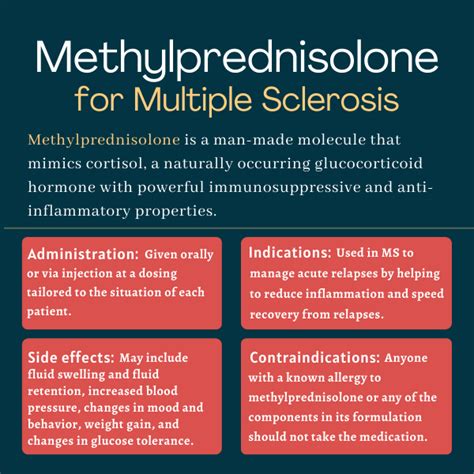
Common Conditions Treated with Methylprednisolone
Some of the most common conditions treated with methylprednisolone include: * Rheumatoid arthritis * Asthma * Multiple sclerosis * Lupus * Allergic reactions * Anaphylaxis * Organ transplantation * Certain types of cancer Methylprednisolone can be used to treat a wide range of conditions, and its versatility makes it a valuable treatment option for many patients.Methylprednisolone Side Effects and Interactions
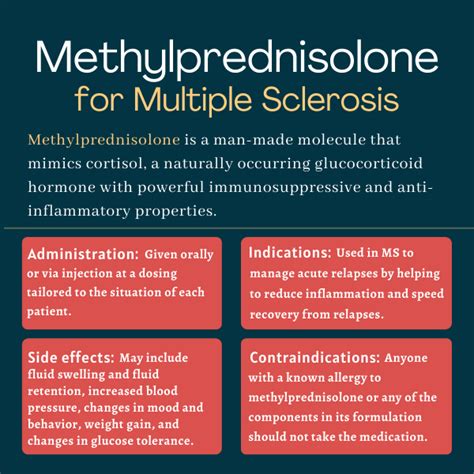
Managing Side Effects and Interactions
To manage side effects and interactions, patients should follow their doctor's instructions carefully and report any changes in their symptoms or condition. It is essential to monitor blood sugar levels, blood pressure, and liver function regularly, especially when taking methylprednisolone for extended periods. Patients should also avoid taking other medications or substances that can interact with methylprednisolone, and should inform their doctor about any other medications or supplements they are taking.Methylprednisolone Dosage and Administration
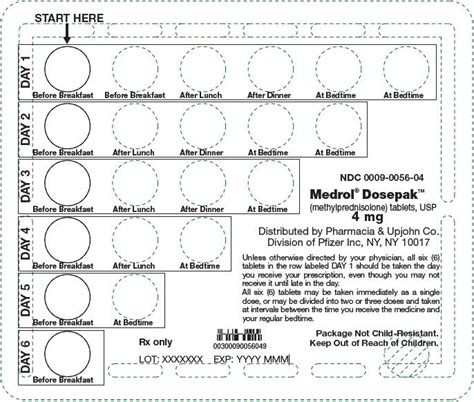
Guidelines for Dosage and Administration
To ensure safe and effective use of methylprednisolone, patients should follow these guidelines: * Take the medication exactly as prescribed by the doctor * Do not exceed the recommended dosage or duration of treatment * Monitor blood sugar levels, blood pressure, and liver function regularly * Avoid taking other medications or substances that can interact with methylprednisolone * Inform the doctor about any other medications or supplements being takenMethylprednisolone Contraindications and Warnings
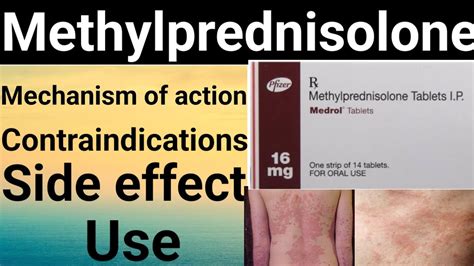
Special Precautions and Warnings
Patients should be aware of the following special precautions and warnings: * Methylprednisolone can cause dizziness and drowsiness, so patients should avoid driving or operating heavy machinery * The medication can increase the risk of infection, so patients should avoid contact with people who have infectious diseases * Methylprednisolone can cause mood changes, so patients should report any changes in their emotional state to their doctorMethylprednisolone Overdose and Toxicity
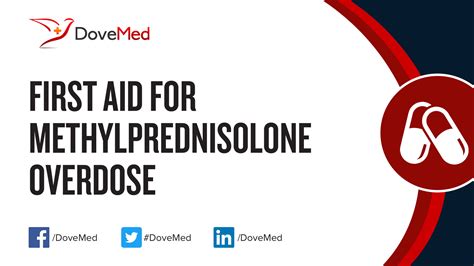
Managing Overdose and Toxicity
To manage overdose and toxicity, patients should follow these steps: * Seek medical attention immediately * Provide the doctor with a complete medical history, including the dosage and duration of treatment * Monitor blood sugar levels, blood pressure, and liver function regularly * Avoid taking other medications or substances that can interact with methylprednisoloneWhat is methylprednisolone used for?
+Methylprednisolone is used to treat a wide range of inflammatory conditions, including arthritis, asthma, and allergies.
What are the common side effects of methylprednisolone?
+Common side effects of methylprednisolone include weight gain, mood changes, and increased blood sugar levels.
How should I take methylprednisolone?
+Methylprednisolone should be taken exactly as prescribed by the doctor, with the typical dosage range being 4-48 mg per day.
Can I take methylprednisolone with other medications?
+Patients should avoid taking other medications or substances that can interact with methylprednisolone, and should inform their doctor about any other medications or supplements they are taking.
What are the contraindications and warnings for methylprednisolone?
+Methylprednisolone has several contraindications and warnings, including hypersensitivity to the medication, fungal infections, and certain types of cancer.
In summary, methylprednisolone is a powerful steroid that can be used to treat a wide range of inflammatory conditions. While the medication has several benefits, it can also cause significant side effects and interactions, and patients should use it responsibly and under the guidance of a healthcare professional. By understanding the mechanism of action, uses, and side effects of methylprednisolone, patients can make informed decisions about their treatment and work with their doctor to develop a safe and effective treatment plan. We encourage readers to share their experiences with methylprednisolone, ask questions, and seek medical attention if they have any concerns about their treatment.
